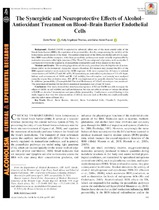| dc.description.abstract | Background: Alcohol (EtOH) is reported to adversely affect one of the most crucial roles of the blood–brain barrier (BBB), the regulation of its permeability, thereby compromising the stability of the homeostatic environment of the brain. The central component of the BBB, endothelial cells (ECs), regulates BBB transcellular transport, while their paracellular pathways are made virtually impermeable by molecular structures called tight junctions (TJs). These TJs are composed of proteins, such as claudin-5, a protein involved in the regulation of paracellular permeability and of key interest in this study. Methods and Results: The working hypothesis of this study postulated that the high levels of antioxidants (AOs) in the fermented Aspalathus linearis (Rooibos; Rf) tincture may protect the ECs of the BBB against oxidative stress induced by EtOH exposure. Cells were exposed for 24 hours to selected concentrations of EtOH (25 and 100 mM), Rf (containing an antioxidant equivalence of 1.9 nM Aspalathin), and cotreatments of EtOH and Rf. Cell viability, live cell number, and toxicity were analyzed using the trypan blue exclusion assay. RT-qPCR was implemented to quantify claudin-5 transcription. In addition, permeability (Transepithelial Electrical Resistance) of bEnd5 monolayers was measured. The experimental timeline for the above-mentioned parameters was 24 and 48 hours. Conclusions: Our study showed that simultaneous exposure of Rf and EtOH was able to negate the effects of EtOH on cell viability and cell proliferation, but was not able to reverse or reduce the effects of EtOH on claudin-5 transcription and paracellular permeability. Furthermore, a novel finding in this study suggests that very low concentrations of AOs in tinctures such as Rooibos tea could profoundly alter the redox status of brain ECs. | en_US |

